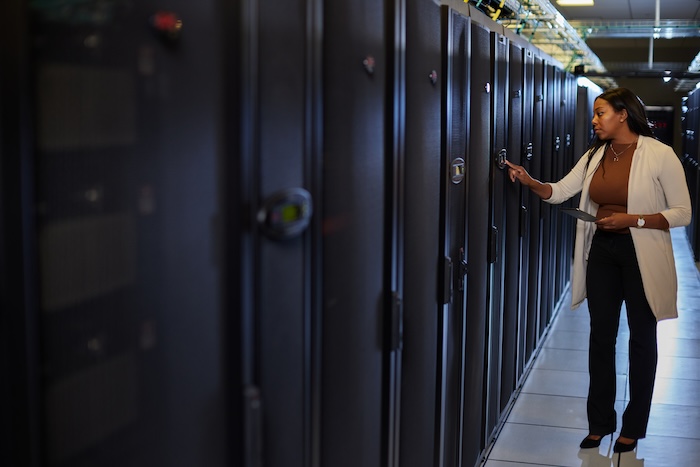
Data centres: Ensuring continuity for computations
February 6, 2024
By James See
Data centre operators need to navigate many challenges to achieve resilience and sustainability.
In 2023, operators of large data centres in London, England, struggled to keep their servers cool as temperatures rose. Ultimately, several of these facilities had to be shut down after their redundant cooling systems failed.
Put simply, temperatures had exceeded their design parameters. While this particular news attracted much attention, London’s data centres are hardly alone in contending with unexpected environmental and energy-related volatility in recent years. Their struggle in maintaining operations is a stark reminder that has also resonated in Canada, where the same threats constrain uptime, profitability and the engineering of new facility locations.
The growing demand for data centres in the face of the environmental challenges of climate change underscores the urgency to take proactive measures to ensure resilience and sustainability. And as changes in the energy system precipitate further volatility in 2024, it is certainly time for improvements in efficiency, the diversification of procurement and the engineering of on-site energy systems.
Challenges
The following are three key challenges:
1. Energy cost volatility
Climate change, geopolitical tensions and supply chain stress combined to causes record levels of energy price volatility in 2022 and continued risk in 2023. Canada, where the energy sector constituted 11.8% of gross domestic product (GDP) in 2022, is not immune.
Ranking sixth globally in total primary energy production, Canada faces such challenges as aging infrastructure, stringent environmental regulations and market access issues. These factors contribute to the complexity of managing energy costs and sustainability. The resulting volatility can make it difficult for data centre operators to attract capital, plan investments and anticipate profitability.
Proactive measures are urgently needed.
2. Grid constraints
Grid power and transmission capacity represent a growing constraint on the construction and placement of data centres, further contributing to energy price uncertainty for their operators. For a sense of perspective, data centres consume about 1% of Canada’s energy every year. About 50% of this energy powers the servers, while another 40% goes into cooling them.
Throughout 2024, the proliferation of artificial intelligence (AI) technologies, with their high demands for computational power, will exert additional pressure on already strained electrical grids, amplifying the uncertainties facing data centre operations.
3. Increasingly frequent and severe outages
Climate change is challenging grid reliability in multiple ways, including droughts, wildfires and severe storms.
In April 2023, an ice storm caused the largest power outage in Quebec since 1998, affecting hundreds of thousands of people. In the U.S., meanwhile, power outages caused by severe weather are growing in frequency and duration. Long-term outages, like those precipitated by wildfires in California and freezes in Texas, can challenge a data centre’s store of diesel fuel for backup generators and, for that matter, intensify competition for supply and impede delivery. Extreme weather can also impact data centres’ energy infrastructure directly, threatening on-site transformers and distribution equipment.
Incidents of sabotage are also on the rise.
The proliferation of AI is increasing demand for computational power.
Solutions
The following are three ways for data centre operators to address the challenges of energy volatility:
1. Energy efficiency upgrades
The first step is to maximize a data centre’s energy efficiency. This metric, expressed as ‘power usage effectiveness’ (PUE), is a ratio between the total energy consumed by the facility and the actual energy delivered to the servers and related equipment. Thus, operators aim for the lowest PUE possible, at 1.0.
Over the past five years, the industry-wide average PUE has remained relatively flat. New innovations will be necessary for further gains.
Some such developments coming to operators include new cooling systems, increasingly efficient uninterruptible power supplies (UPSs) and advanced power, building and information technology (IT) monitoring and control systems. Running a UPS in high-efficiency mode, for example, can save hundreds of thousands of dollars for a typical data centre, over the life of the UPS. Data centre infrastructure management (DCIM) software can monitor both IT equipment and the underlying infrastructure, to help improve operational efficiency, while digital twin platforms can expedite the digitization process throughout the complete life cycle of power systems.
2. Energy procurement diversification
A diverse energy portfolio can help data centre operators manage volatility. Renewable energy sources are shielded from fuel cost fluctuations, reduce the facility’s carbon footprint, help combat climate change and mitigate future volatility.
Strategic investment in off-site renewables can help add clean capacity to the power grid, which can not only help to alleviate constraints, but also demonstrate to the public that the data centre is acting in the community’s interests.
Running a UPS in high-efficiency mode can save hundreds of thousands of dollars.
3. On-site energy resources/microgrids
Increasingly, data centre operators are looking to replace backup diesel generation with on-site energy resources (both generation and storage) to facilitate grid interaction and as a cleaner solution for primary power.
For one thing, a microgrid built around larger-capacity assets—such as a natural gas-based generator or fuel cell—could allow a facility to withstand longer grid power outages than would be feasible with on-site diesel fuel storage. For another, it can be controlled to optimize cost performance through automated grid interaction. Reducing the load on the grid can help to relieve congestion and associated public opposition.
Energy market volatility is likely to continue as systems undergo fundamental restructuring and the impacts of climate change grow. Data centre operators need to protect their operations from cost fluctuations and outages. At the same time, they must convince their host communities they are part of the solution, not competitors for scarce resources.
Of course, no one can realize this potential alone. Operators, engineers and technology providers must come together as partners to develop and adopt new solutions and propel the evolution of a more sustainable, resilient and predictably profitable data centre industry.
James See is national sales director for Schneider Electric Canada’s systems business, interacting with data centre and IT infrastructure clients. For more information, visit www.se.com/ca.
